An Experimental Study on Mud Adhesion Performance of a PDC Drill Bit Based on a Biomimetic Non-Smooth Surface
Abstract
1. Introduction
2. Materials and Methods
3. Results
3.1. Experimental Bench
3.2. Anti-Adhesion Experiment
4. Analysis
- (1)
- The influence of the morphology of non-smooth surface unit structures on adhesion performance is compared. The adhesion force generated by three types of non-smooth surface unit structures is the smallest in the normal direction for small dot pit specimens and the largest in the normal direction for big square raised specimens [61]. Therefore, it can be concluded that the anti-adhesion effect of the three types of non-smooth surface unit structures is the best for small dot pit specimens, while the anti-adhesion effect is the worst for big square raised specimens.
- (2)
- The influence of non-smooth surface unit size on adhesion performance is examined. The normal adhesion force generated by three types of non-smooth surface unit structures increases with the increase in unit size, and the smaller the unit structure size, the closer it is to the surface size of the organism, and the better the anti-adhesion effect. Under the allowable processing conditions and material properties, the structural dimensions of non-smooth surface units should be as close as possible to the surface dimensions of the organism.
- (3)
- The influence of contact time between specimens and clay on adhesion performance is examined. The normal adhesion force between specimens and clay in three types of non-smooth surface unit structure specimens increases with increasing contact time. When the contact time reaches the critical contact time, as shown in Table 5, the adhesion force tends to stabilize. The critical contact time of smooth surface specimens is 9 h, and the adhesion force is 540 Pa. All non-smooth surface specimens did not reach this adhesion force value during the test contact time, further verifying that non-smooth surfaces have anti-adhesion performance.
5. Conclusions
- (1)
- In response to the problem of bit balling easily formed by PDC drill bits during drilling in muddy formations, the non-smooth surface morphology in biomimetics is applied to the surface structure design of PDC drill bits. The morphology, size, and arrangement of the non-smooth surface unit units of living organisms are analyzed, and a non-smooth surface unit structure specimen with a certain anti-adhesion function is designed.
- (2)
- Design an experimental bench and use indoor experimental methods to test the normal adhesion force of non-smooth surface specimens under different morphologies, sizes, and contact times. The normal adhesion force with a contact time of 12 h is as follows: 340 Pa of big square raised, 250 Pa of middle square raised, 190 Pa of small square raised, 315 Pa of big circular groove, 280 Pa of middle circular groove, 200 Pa of small circular groove, 225 Pa of big dot pit, 205 Pa of middle dot pit, and 130 Pa of small dot pit. Compared with the normal adhesion force of 550 Pa for smooth surface specimens with a contact time of 12 h, the anti-adhesion properties of the three non-smooth surface unit structure specimens designed in this paper were verified to have anti-adhesion properties.
- (3)
- Analyze the influence of three factors: non-smooth surface morphology, size, and contact time with clay on the magnitude of adhesion force. At the critical contact time when the adhesion force tends to stabilize, the adhesion forces of different specimens are as follows: 330 Pa of big square raised, 237.5 Pa of middle square raised, 175 Pa of small square raised, 290 Pa of big circular groove, 250 Pa of middle circular groove, 160 Pa of small circular groove, 210 Pa of big dot pit, 185 Pa of middle dot pit, and 115 Pa of small dot pit. The results show that the anti-adhesion effect of small dot pit structures is the best, while the anti-adhesion effect of big square raised structures is the worst. The smaller the size of the unit structure, the closer it is to the surface size of the organism, and the shorter the contact time with clay, the better the anti-adhesion effect.
Author Contributions
Funding
Data Availability Statement
Acknowledgments
Conflicts of Interest
References
- Zhang, W.B.; Shi, H.Z.; Xi, C.M.; Zhang, N.; Xiong, C.; Chen, Z. Experimental study on rock cutting with the combination of conical diamond elements and conventional PDC cutters. China Pet. Mach. 2023, 51, 33–39. [Google Scholar]
- Wang, W.; Cheng, Z.Y.; Chen, X.Y.; Xu, Y.; Peng, G. Design and application of pulse cavitation PDC bit. China Pet. Mach. 2021, 49, 24–30+38. [Google Scholar]
- Deng, R.; He, X.J.; Huang, A.L. Experimental study on rock crack characteristics of PDC cutter in the process of rock breaking. Pet. Drill. Tech. 2024, 52, 38–44. [Google Scholar]
- Wen, X.; Liu, G.; Li, J.; Zha, C.; Guo, X. A study of newly compound impactor aiming to mitigate stick-slip vibration on drill bit for deep formations. Chem. Technol. Fuels Oils 2025, 60, 1668–1675. [Google Scholar] [CrossRef]
- Smith, J.R.; Lund, J.B.; Galloway, R.K. Friction on PDC cutters at high normal stress. J. Energy Resour. Technol. 2002, 124, 146–153. [Google Scholar] [CrossRef]
- Detournay, E.; Richard, T.; Shepherd, M. Drilling response of drag bits: Theory and experiment. Int. J. Rock Mech. Min. Sci. 2008, 45, 1347–1360. [Google Scholar] [CrossRef]
- Wang, B.; Li, J.; Zou, D.Y.; Yang, H.; Huang, T. Mechanisms and distribution pattern of abrasions on PDC bits for highly-abrasive hard-rock. Spec. Oil Gas Reserv. 2018, 25, 149–153. [Google Scholar]
- Hu, H.; Guan, Z.; Zhang, B.; Xu, Y.; Liu, Y.; Wang, B. Structured design of weight-on-bit self-adjusting PDC bit based on stress field analysis and experiment evaluation. J. Pet. Sci. Eng. 2021, 196, 1076–1092. [Google Scholar] [CrossRef]
- Liu, X.; Zou, D.; Yu, J.; Cui, Y. Experimental research on the impregnated diamond bit wear model. Chem. Technol. Fuels Oils 2023, 59, 113–122. [Google Scholar] [CrossRef]
- Lei, M.; Sun, J.S.; Zhu, H.Y.; Huang, W.; Cai, Z. Synthesis and characterization of natural rosin-modified silica nanocomposite and its green multifunctional applications for drilling fluid. Colloids Surf. A Physicochem. Eng. Asp. 2024, 702, 134994. [Google Scholar] [CrossRef]
- Li, Q.; Li, Q.; Cao, H.; Wu, J.; Wang, F.; Wang, Y. The Crack Propagation Behaviour of CO2 Fracturing Fluid in Unconventional Low Permeability Reservoirs: Factor Analysis and Mechanism Revelation. Processes 2025, 13, 159. [Google Scholar] [CrossRef]
- Shirvanimoghaddam, K.; Balaji, K.V.; Yadav, R.; Zabihi, O.; Ahmadi, M.; Adetunji, P.; Naebe, M. Balancing the toughness and strength in polypropylene composites. Compos. Part B Eng. 2021, 223, 109121. [Google Scholar] [CrossRef]
- Liu, Y.Z.; Lei, J.Y.; Wang, Z.H. Dynamic response of nacre-like brick and mortar structure under impact load. Chin. J. High-Press. Phys. 2022, 36, 125–133. [Google Scholar]
- Junior, W.K.; Guanabara, A.S. Methodology for product design based on the study of bionics. Mater. Des. 2005, 26, 149–155. [Google Scholar] [CrossRef]
- Li, Q.; Li, Q.; Wu, J.; Li, X.; Li, H.; Cheng, Y. Wellhead stability during development process of hydrate reservoir in the Northern South China Sea: Evolution and mechanism. Processes 2025, 13, 40. [Google Scholar] [CrossRef]
- Cao, P.L.; Gao, K.; Wang, W.L.; Yin, K. Optimization design and testing of stepped impact compaction drill bit structure. Pet. Mach. 2009, 37, 20–23. [Google Scholar]
- Zhang, C.; Yang, X.; Zhu, Z.; Ke, X.; Zhang, Z.; Luo, H.; Ma, Y.; Song, D. Experimental study on shale-breaking of special-shaped cutter PDC bit. Geomech. Geophys. Geo-Energy Geo-Resour. 2024, 10, 123. [Google Scholar] [CrossRef]
- Li, Q.; Wu, J.; Li, Q.; Wang, F.; Cheng, Y. Sediment Instability Caused by Gas Production from Hydrate-Bearing Sediment in Northern South China Sea by Horizontal Wellbore: Sensitivity Analysis. Nat. Resour. Res. 2025, 34, 1667–1699. [Google Scholar]
- Liang, X.; Shan, C.A.; Wang, W.; Li, Z.; Zhu, D.; Xu, J.; Zhang, Z.; Zhang, Z.; Luo, Y.; Yuan, X. Exploration and development in the Zhaotong national shale gas demonstration area: Progress and prospects. Nat. Gas Ind. B 2023, 10, 44–61. [Google Scholar] [CrossRef]
- Li, Q.; Li, Q.; Wang, F.; Wu, J.; Wang, Y. The carrying behavior of water-based fracturing fluid in shale reservoir fractures and molecular dynamics of sand-carrying mechanism. Processes 2024, 12, 2051. [Google Scholar] [CrossRef]
- Liu, W.; Deng, K.; Li, R.; Li, L.; Zhu, X.; Gong, S. The performance and failure mechanism of drill bit in granite formation drilling. Res. Artic. Pet. Eng. 2023, 48, 9477–9492. [Google Scholar] [CrossRef]
- Li, Q.; Li, Q.; Han, Y. A numerical investigation on kick control with the displacement kill method during a well test in a deep-water gas reservoir: A case study. Processes 2024, 12, 2090. [Google Scholar] [CrossRef]
- Wu, Z.; Yuan, R.; Zhang, W.; Liu, J.; Hu, S. Structure design of bionic PDC cutter and the characteristics of rock breaking processes. Processes 2023, 12, 66. [Google Scholar] [CrossRef]
- Qiao, J.; Zhu, L.N.; Yue, W.; Fu, Z.Q.; Kang, J.J.; Wang, C.B. The effect of attributes of micro-shapes of laser surface texture on the wettability of WC-CrCo metal ceramic coatings. Surf. Coat. Technol. 2018, 334, 429–437. [Google Scholar] [CrossRef]
- Kerr, C.J. PDC drill bit design and field application evolution. J. Pet. Technol. 1988, 40, 327–332. [Google Scholar] [CrossRef]
- Yang, Y.; Yang, Y.; Ren, H.; Qi, Q.; Chen, X. Research on the working mechanism of the PDC drill bit in compound drilling. J. Pet. Sci. Eng. 2020, 185, 106647. [Google Scholar] [CrossRef]
- Mazen, A.Z.; Mujtaba, I.M.; Hassanpour, A.; Rahmanian, N. Mathematical modelling of performance and wear prediction of PDC drill bits: Impact of bit profile, bit hydraulic, and rock strength. J. Pet. Sci. Eng. 2020, 188, 106849. [Google Scholar] [CrossRef]
- Taylor, M.R.; Murdock, A.D.; Evans, S.M. High penetration rates and extended bit life through revolutionary hydraulic and mechanical design in PDC drill bit development. SPE Drill. Complet. 1999, 14, 34–41. [Google Scholar] [CrossRef]
- Liu, Y.; Zhou, L.; Wan, X.; Tang, Y.; Liu, Q.; Li, W.; Liao, J. Synthesis and Characterization of a Temperature-Sensitive Microcapsule Gelling Agent for High-Temperature Acid Release. ACS Omega 2024, 9, 20849–20858. [Google Scholar] [CrossRef]
- Pessier, R.; Damschen, M. Hybrid bits offer distinct advantages in selected roller-cone and PDC-bit applications. SPE Drill. Complet. 2011, 26, 96–103. [Google Scholar] [CrossRef]
- Panayirci, H.M. An experimental study on steering response of PDC drill bits. J. Pet. Sci. Eng. 2022, 208, 109440. [Google Scholar] [CrossRef]
- Huang, K.; Ai, Z.; Yang, Y.; Xie, Z. The improved rock breaking efficiency of an annular-groove PDC bit. J. Pet. Sci. Eng. 2019, 172, 425–435. [Google Scholar] [CrossRef]
- Li, Q.; Liu, J.; Wang, S.; Guo, Y.; Han, X.; Li, Q.; Cheng, Y.; Dong, Z.; Li, X.; Zhang, X. Numerical insights into factors affecting collapse behavior of horizontal wellbore in clayey silt hydrate-bearing sediments and the accompanying control strategy. Ocean Eng. 2024, 297, 117029. [Google Scholar] [CrossRef]
- Mao, L.; He, J.; Zhu, J.; Jia, H.; Gan, L. Dynamic characteristic response of PDC bit vibration coupled with drill string dynamics. Geoenergy Sci. Eng. 2024, 233, 212524. [Google Scholar] [CrossRef]
- Bondarenko, A.V.; Islamov, S.R.; Ignatyev, K.V.; Mardashov, D.V. Laboratory studies of polymer compositions for well-kill under increased fracturing. Perm J. Pet. Min. Eng. 2020, 20, 37–48. [Google Scholar] [CrossRef]
- Belousov, A.; Lushpeev, V.; Sokolov, A.; Sultanbekov, R.; Tyan, Y.; Ovchinnikov, E.; Shvets, A.; Bushuev, V.; Islamov, S. Experimental Research of the Possibility of Applying the Hartmann–Sprenger Effect to Regulate the Pressure of Natural Gas in Non-Stationary Conditions. Processes 2025, 13, 1189. [Google Scholar] [CrossRef]
- Li, Q.; Wang, Y.; Wang, F.; Li, Q.; Kobina, F.; Bai, H.; Yuan, L. Effect of a modified silicone as a thickener on rheology of liquid CO2 and its fracturing capacity. Polymers 2019, 11, 540. [Google Scholar] [CrossRef]
- Pryhorovska, T.O.; Chaplinskiy, S.S.; Kudriavtsev, I.O. Finite element modelling of rock mass cutting by cutters for PDC drill bits. Pet. Explor. Dev. 2015, 42, 888–892. [Google Scholar] [CrossRef]
- Liu, C.; Zheng, X.; Wang, G.; Xu, M.; Li, Z. Research on drilling response characteristics of two-wing PDC bit. Sustainability 2020, 12, 406. [Google Scholar] [CrossRef]
- Abbas, R.K. A review on the wear of oil drill bits (conventional and the state of the art approaches for wear reduction and quantification). Eng. Fail. Anal. 2018, 90, 554–584. [Google Scholar] [CrossRef]
- Zhang, J.; Cui, M.; Wang, Q.; Ren, H.; Ji, G.; Shao, F.; Zhuo, L.; Li, H.; Yu, J. Experimental study on rock drilling vibration of PDC bit in interbedded formations. Geoenergy Sci. Eng. 2025, 244, 213452. [Google Scholar] [CrossRef]
- Wang, Z.; Wang, C.; Feng, S.; Li, N.; Zhang, Z.; Fan, Y. Mechanism and Experimental Research on Rock Breaking by Cutting Teeth of High-Speed PDC Drill Bit. Processes 2025, 13, 1213. [Google Scholar] [CrossRef]
- Zhang, C.; Zhao, Y.; Gao, K.; Zhang, C.; Lv, X.; Xie, X. Simulation and experimental investigations of ultrasonic-assisted drilling with Micro-PDC bit. Geoenergy Sci. Eng. 2023, 223, 211480. [Google Scholar] [CrossRef]
- Motahhari, H.R.; Hareland, G.; James, J.A. Improved drilling efficiency technique using integrated PDM and PDC bit parameters. J. Can. Pet. Technol. 2010, 49, 45–52. [Google Scholar] [CrossRef]
- Kuang, Y.; Zhang, M.; Feng, M.; Zhang, Y.; Han, Y.; Peng, Y. Simulation and experimental research of PDC bit cutting rock. J. Fail. Anal. Prev. 2016, 16, 1101–1107. [Google Scholar] [CrossRef]
- Ersoy, A.; Waller, M.D. Drilling detritus and the operating parameters of thermally stable PDC core bits. Int. J. Rock Mech. Min. Sci. 1997, 34, 1109–1123. [Google Scholar] [CrossRef]
- Tu, J.; Wang, X.; Dai, W.; Zhang, H.; Liu, B. Performance improvement of PDC and PDC bits by cryogenic treatment. Geoenergy Sci. Eng. 2023, 221, 211350. [Google Scholar] [CrossRef]
- Gao, K.; Xu, X.; Jiao, S.; Li, Z. Modeling and experimental research on temperature field of full-sized PDC bits in rock drilling and coring. Energy Rep. 2022, 8, 8928–8938. [Google Scholar] [CrossRef]
- Huang, K.; Yang, Y.; Li, G.; Wang, Y.; Ren, H.; Niu, S. Torsion and vibration reduction mechanism of roller PDC hybrid bit. J. Pet. Sci. Eng. 2022, 208, 109491. [Google Scholar] [CrossRef]
- Black, A.D.; Walker, B.H.; Tibbitts, G.A.; Sandstrom, J.L. PDC bit performance for rotary, mud motor, and turbine drilling applications. SPE Drill. Eng. 1986, 1, 409–416. [Google Scholar] [CrossRef]
- Tian, K.; Detournay, E. Influence of PDC bit cutter layout on stick–slip vibrations of deep drilling systems. J. Pet. Sci. Eng. 2021, 206, 109005. [Google Scholar] [CrossRef]
- Taylor, S.; Besson, A.; Minto, D.; Mampuk, I.S. Unique PDC bit technologies combine to reduce drilling time in interbedded formations. SPE Drill. Complet. 2000, 15, 112–117. [Google Scholar] [CrossRef]
- Chen, P.; Miska, S.; Yu, M.; Ozbayoglu, E. Modeling of cutting rock: From PDC cutter to PDC bit—Modeling of PDC bit. SPE J. 2021, 26, 3465–3487. [Google Scholar] [CrossRef]
- Liao, Q.; Cui, G.; Xie, T.; Li, H.; Zhang, L.; Wang, Y. Study on Different Kinds of Drill Bits and Their Usage in Hard-to-Drill Formations. Chem. Technol. Fuels Oils 2023, 59, 783–790. [Google Scholar] [CrossRef]
- Li, Q.; Cheng, Y.; Li, Q.; Zhang, C.; Ansari, U.; Song, B. Establishment and evaluation of strength criterion for clayey silt hydrate-bearing sediments. Energy Sources Part A Recovery Util. Environ. Eff. 2018, 40, 742–750. [Google Scholar] [CrossRef]
- Huang, K.; Zhou, C.; Yang, Y.; Ren, H.; Niu, Q. Working Load Characteristics of the PDC-Cone Composite Bit under Impact and Scraping. Shock Vib. 2020, 2020, 7540519. [Google Scholar] [CrossRef]
- Ozturk, O.M.; Kilic, Z.M.; Altintas, Y. Mechanics and dynamics of orbital drilling operations. Int. J. Mach. Tools Manuf. 2018, 129, 37–47. [Google Scholar] [CrossRef]
- Li, Q.; Wang, Y.; Wang, Y.; San, J.; Li, Q.; Foster, G. Synthetic process on hydroxyl-containing polydimethylsiloxane as a thickener in CO2 fracturing and thickening performance test. Energy Sources Part A Recovery Util. Environ. Eff. 2018, 40, 1137–1143. [Google Scholar] [CrossRef]
- Wang, Q.; Zhang, D.; Tang, K.; Zhang, Y. A mechanics based prediction model for tool wear and power consumption in drilling operations and its applications. J. Clean. Prod. 2019, 234, 171–184. [Google Scholar] [CrossRef]
- Chen, X.; Gao, D.; Guo, B.; Feng, Y. Real-time optimization of drilling parameters based on mechanical specific energy for rotating drilling with positive displacement motor in the hard formation. J. Nat. Gas Sci. Eng. 2016, 35, 686–694. [Google Scholar] [CrossRef]
- Liu, Y.; Zhou, L.; Tang, Y.; Liu, Q.; Li, W.; Zhang, Y. Synthesis and Characterization of a Resin/Acrylamide-2-acrylamide-2-methylpropane Sulfonate-Diallyl Dimethyl Ammonium Chloride-N-vinyl-2-pyrrolidinone Polymer Microcapsule Gelling Agent for Oil and Gas Field Transformation. ACS Omega 2023, 8, 49080–49087. [Google Scholar] [CrossRef] [PubMed]
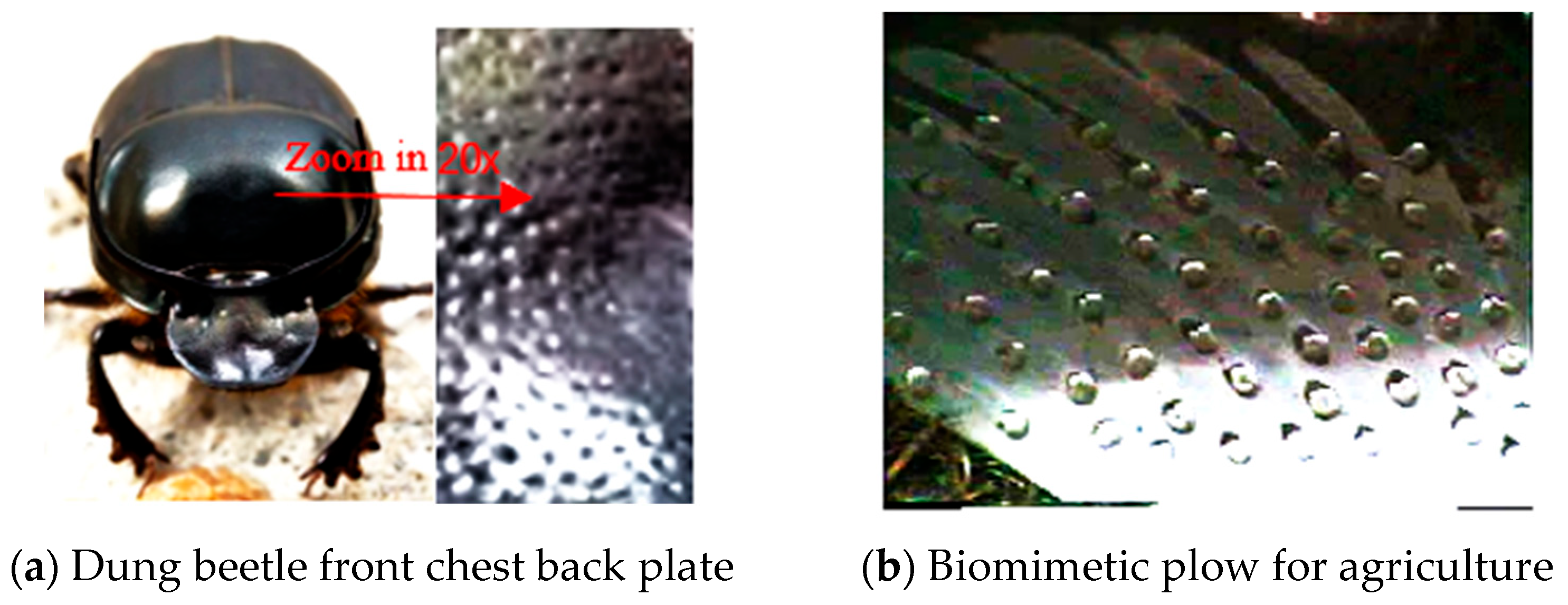
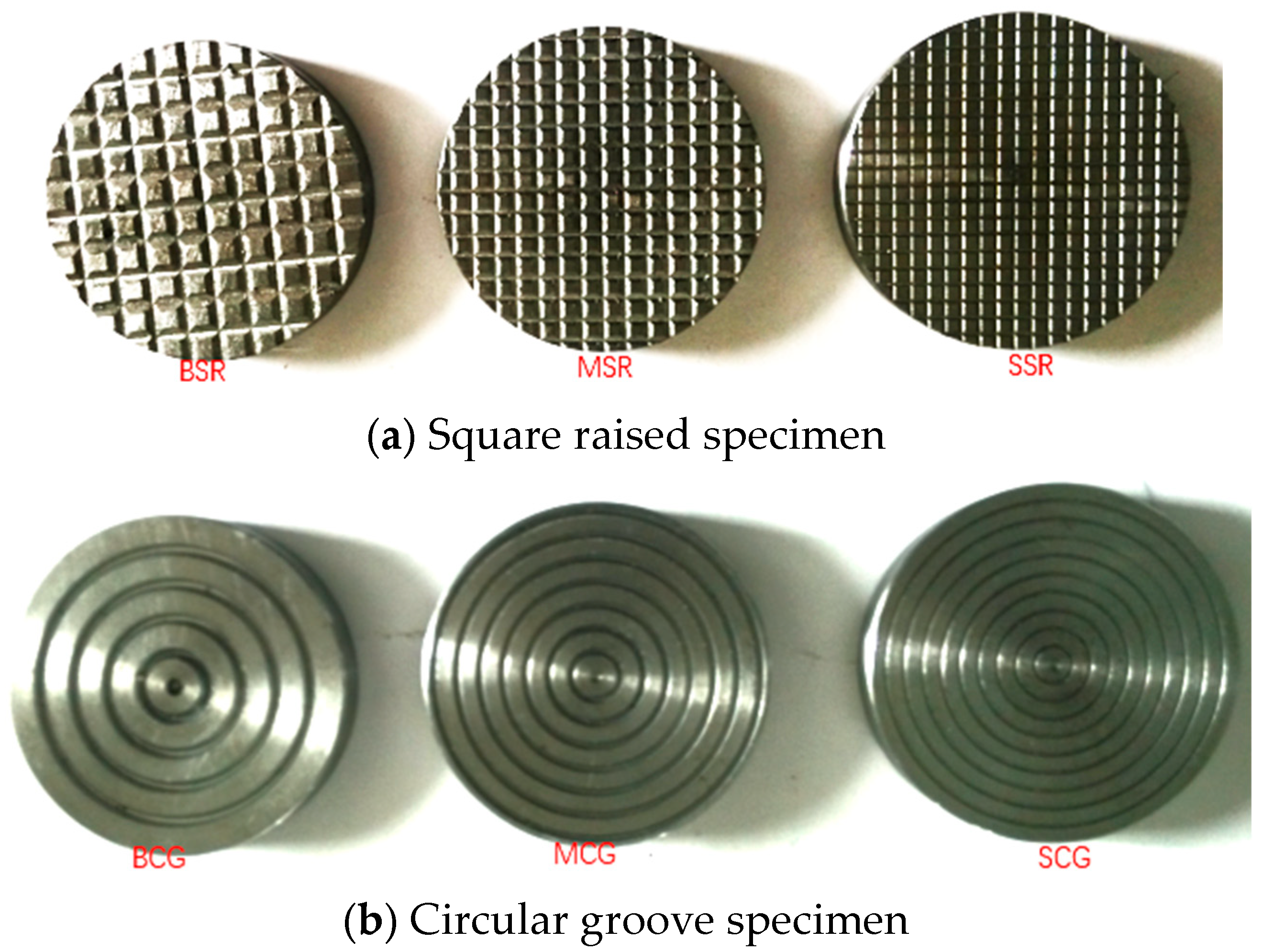
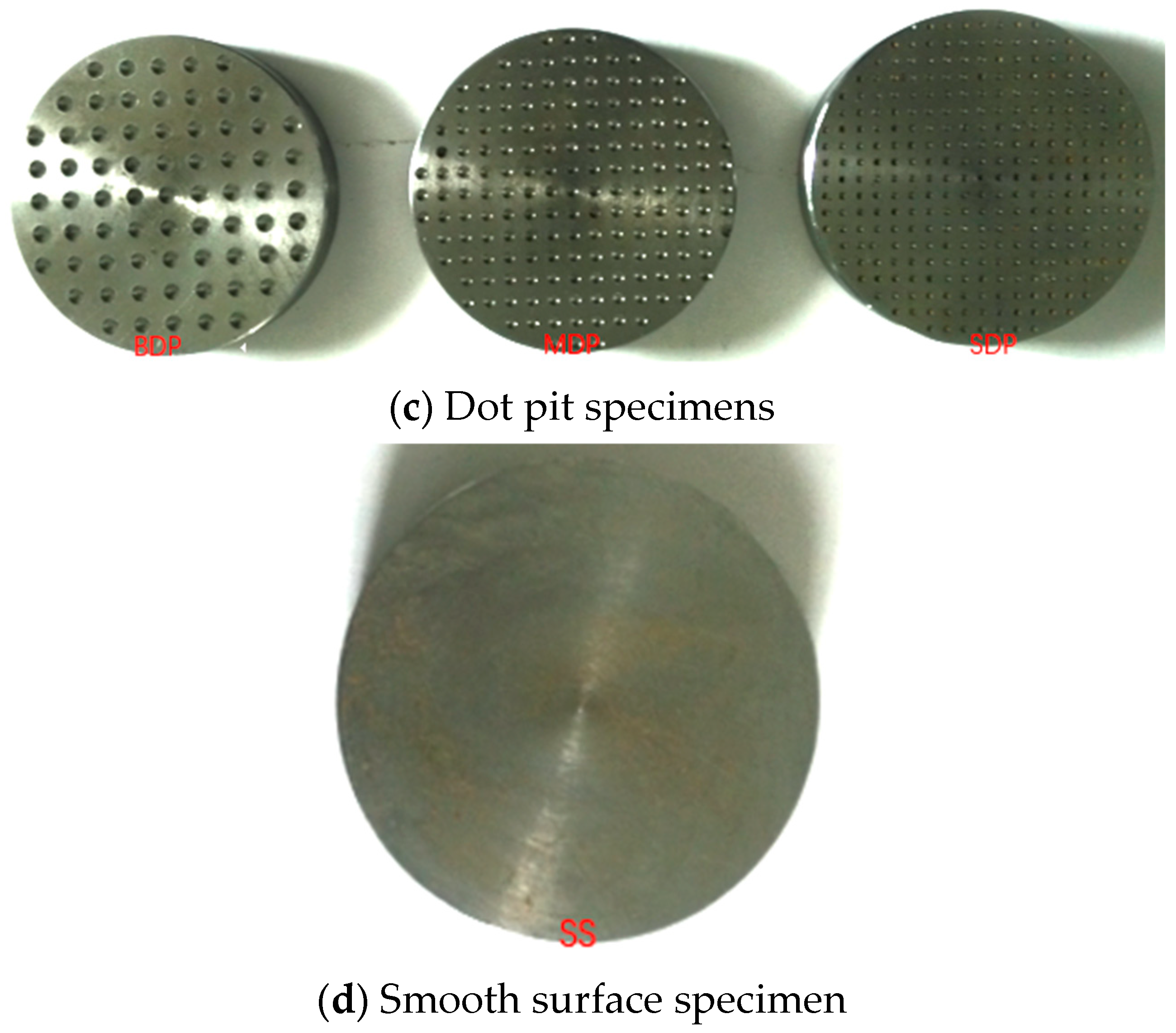
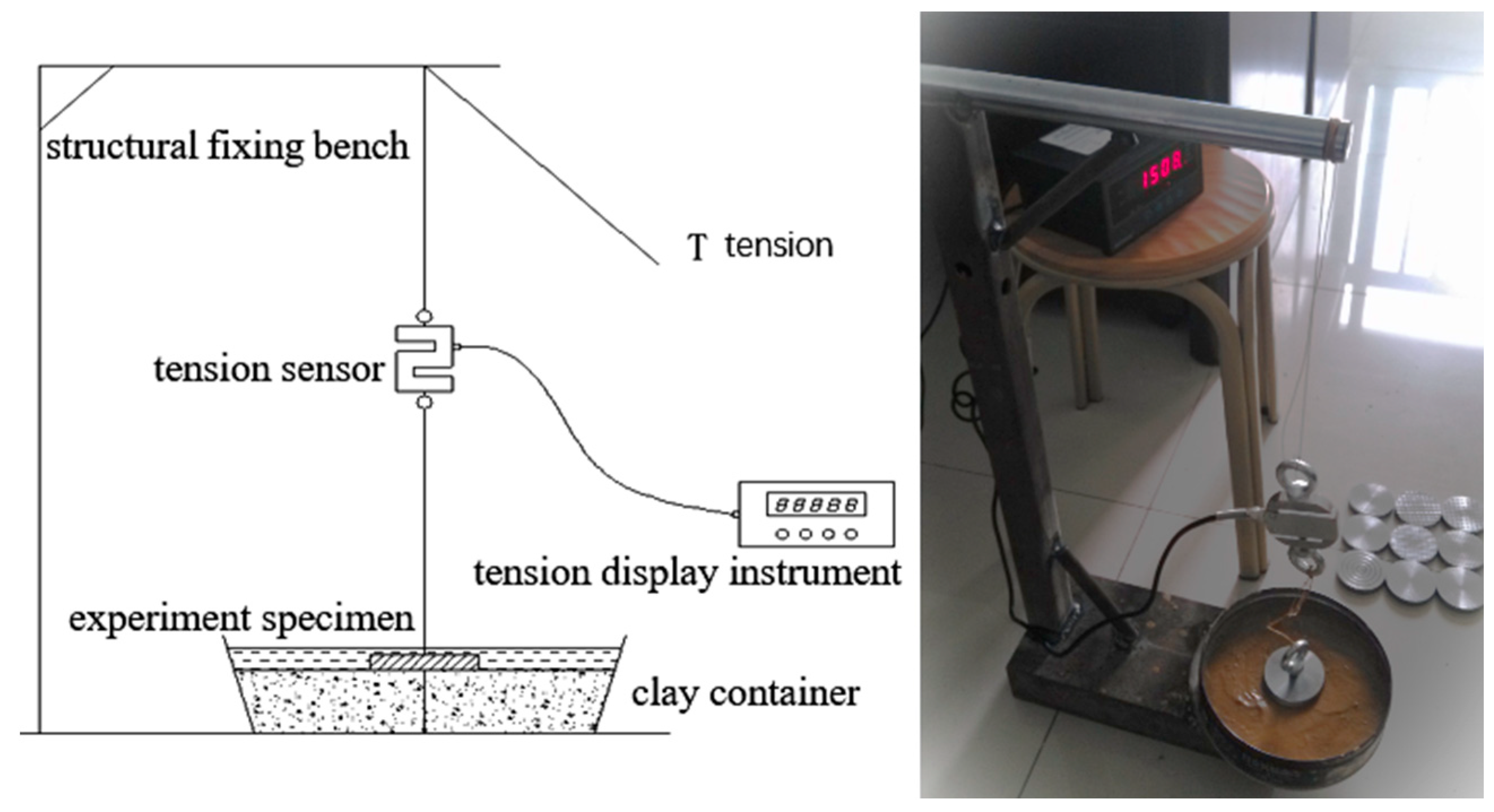
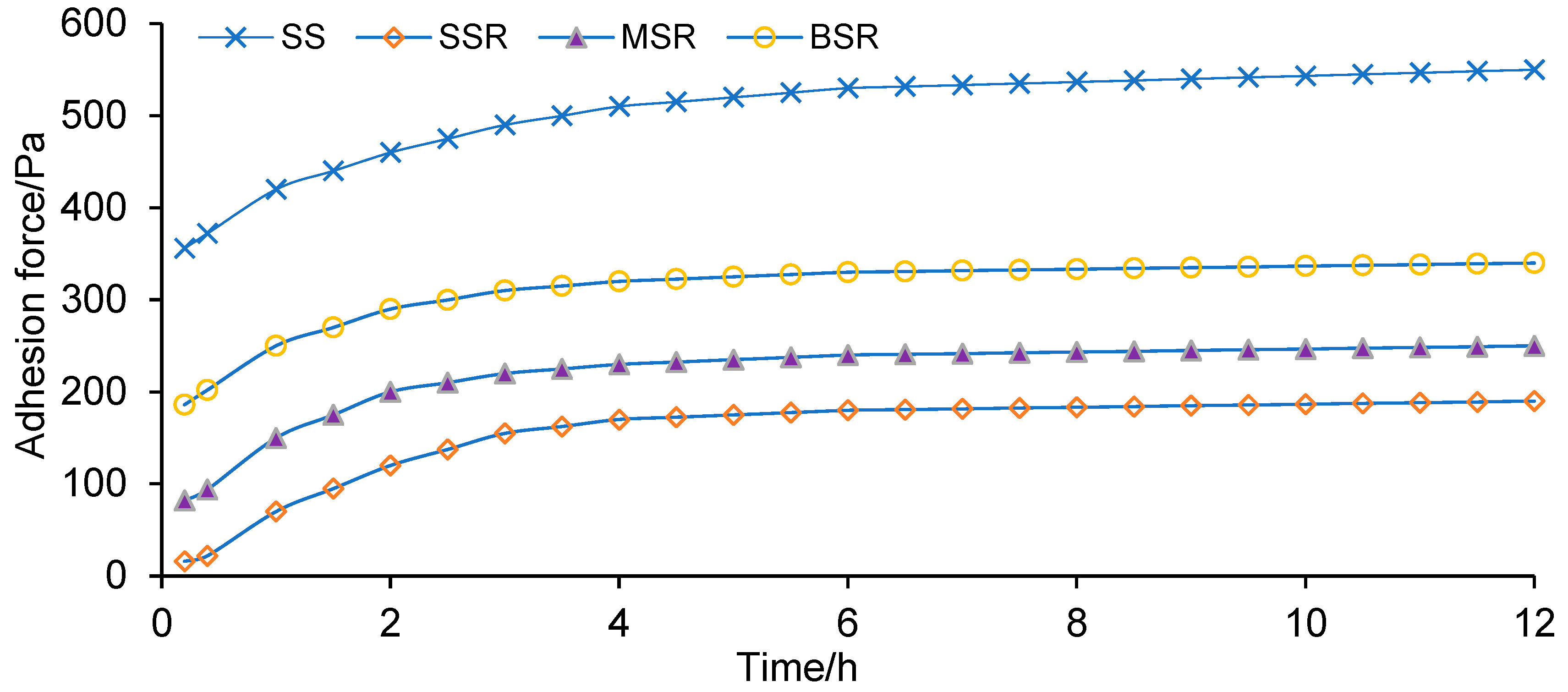
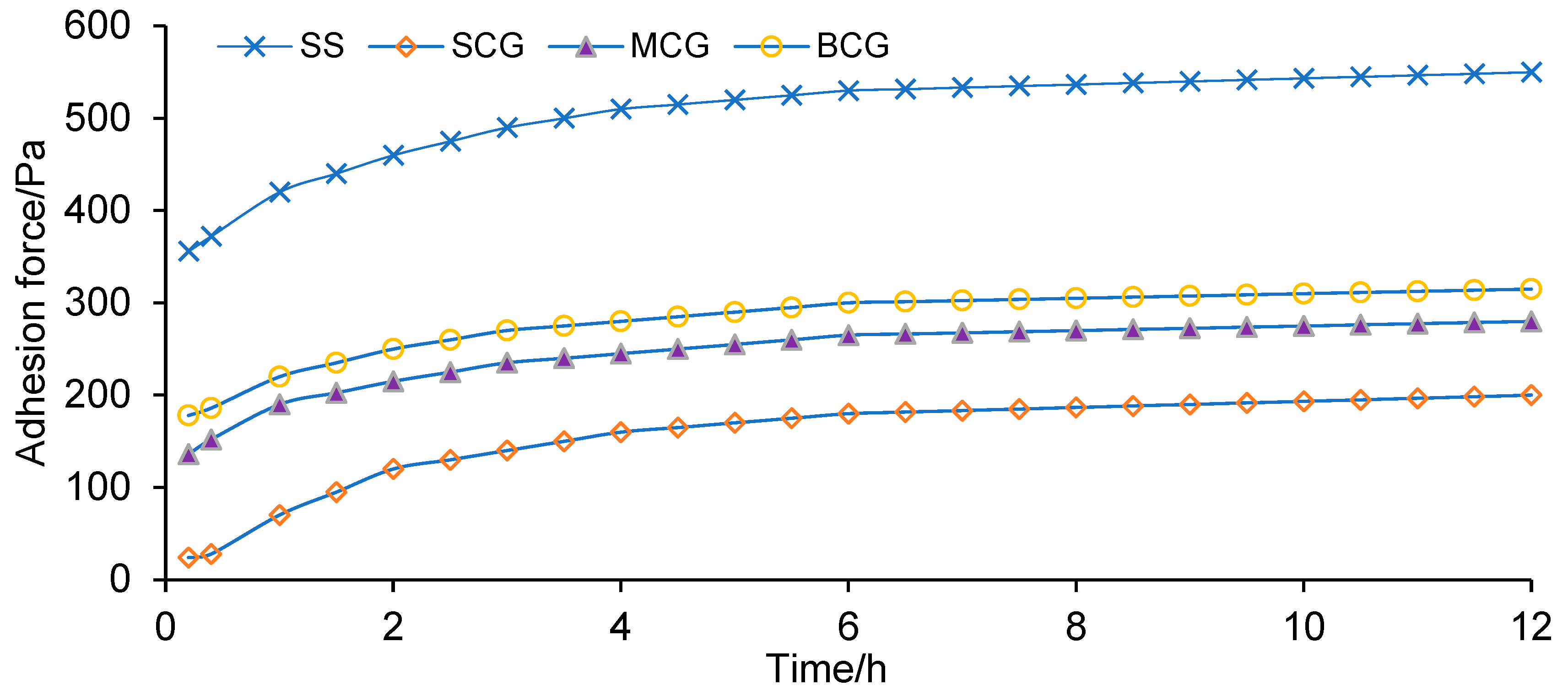
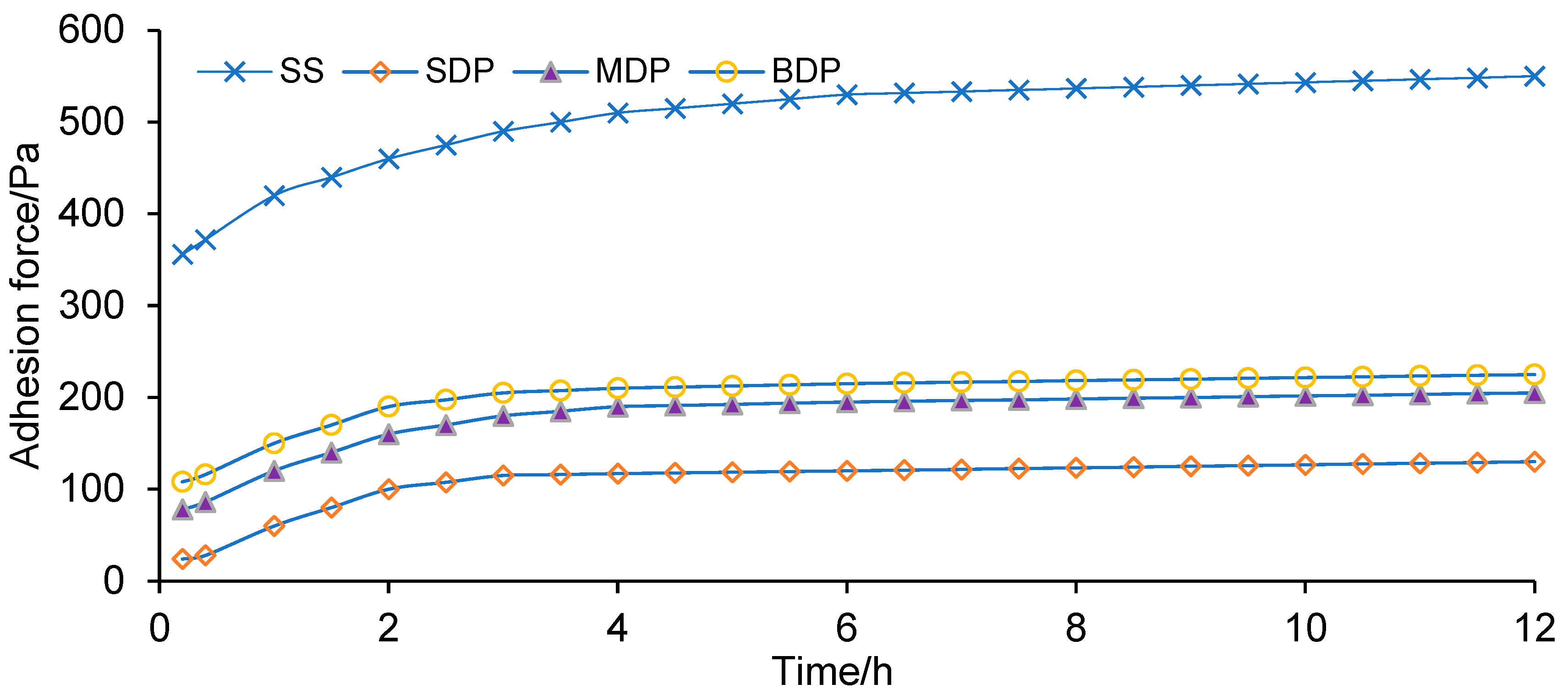
| Biological Name | Conch with Convex Plate | Tooth | Oysters | Dung Beetle Chest and Back Plate | Turbo Cornulus | Spiny Snail |
|---|---|---|---|---|---|---|
| Surface morphology | Protrusion | Protrusion | Pit | Pit | Unevenness | Groove |
| Distribution status | Approximately spherical | Uniformly distributed | Randomly distributed | Uniformly distributed | Randomly distributed | Uniformly distributed |
| Morphology | Specimen Name | Unit Structure Dimensions/mm |
|---|---|---|
| Square Raised | Small Square Raised (SSR) | Side length 1, height 0.5, spacing 1 |
| Middle Square Raised (MSR) | Side length 2, height 1, spacing 2 | |
| Big Square Raised (BSR) | Side length 3, height 1.5, spacing 3 | |
| Circular Groove | Small Circular Groove (SCG) | Slot depth 0.5, width 1, spacing 1 |
| Middle Circular Groove (MCG) | Slot depth 1, width 2, spacing 2 | |
| Big Circular Groove (BCG) | Slot depth 1.5, width 3, spacing 3 | |
| Dot Pit | Small Dot Pit (SDP) | Diameter 1, depth 0.5, spacing 1 |
| Middle Dot Pit (MDP) | Diameter 2, depth 1, spacing 2 | |
| Big Dot Pit (BDP) | Diameter 3, depth 1.5, spacing 3 | |
| Smoothness Surface | SS | / |
| Composition | Quartz | Calcite | Pyrite | Kaolinite | Montmorillonite | Illite | Others |
|---|---|---|---|---|---|---|---|
| Content (%) | 9.39 | 1.55 | 0.8 | 36.52 | 34.31 | 17.13 | 0.3 |
| Specimen Name | BSR | MSR | SMR | BCG | MCG | SCG | BDP | MDP | SDP |
|---|---|---|---|---|---|---|---|---|---|
| Normal adhesion force/Pa | 340 | 250 | 190 | 315 | 280 | 200 | 225 | 205 | 130 |
| Specimen Name | BSR | MSR | SMR | BCG | MCG | SCG | BDP | MDP | SDP |
|---|---|---|---|---|---|---|---|---|---|
| Critical time | 6 h | 5.5 h | 5 h | 5 h | 4.5 h | 4 h | 4 h | 3.5 h | 3 h |
| Adhesion force/Pa | 330 | 237.5 | 175 | 290 | 250 | 160 | 210 | 185 | 115 |
Disclaimer/Publisher’s Note: The statements, opinions and data contained in all publications are solely those of the individual author(s) and contributor(s) and not of MDPI and/or the editor(s). MDPI and/or the editor(s) disclaim responsibility for any injury to people or property resulting from any ideas, methods, instructions or products referred to in the content. |
© 2025 by the authors. Licensee MDPI, Basel, Switzerland. This article is an open access article distributed under the terms and conditions of the Creative Commons Attribution (CC BY) license (https://creativecommons.org/licenses/by/4.0/).
Share and Cite
Chen, M.; Li, Q. An Experimental Study on Mud Adhesion Performance of a PDC Drill Bit Based on a Biomimetic Non-Smooth Surface. Processes 2025, 13, 1464. https://doi.org/10.3390/pr13051464
Chen M, Li Q. An Experimental Study on Mud Adhesion Performance of a PDC Drill Bit Based on a Biomimetic Non-Smooth Surface. Processes. 2025; 13(5):1464. https://doi.org/10.3390/pr13051464
Chicago/Turabian StyleChen, Ming, and Qingchao Li. 2025. "An Experimental Study on Mud Adhesion Performance of a PDC Drill Bit Based on a Biomimetic Non-Smooth Surface" Processes 13, no. 5: 1464. https://doi.org/10.3390/pr13051464
APA StyleChen, M., & Li, Q. (2025). An Experimental Study on Mud Adhesion Performance of a PDC Drill Bit Based on a Biomimetic Non-Smooth Surface. Processes, 13(5), 1464. https://doi.org/10.3390/pr13051464







